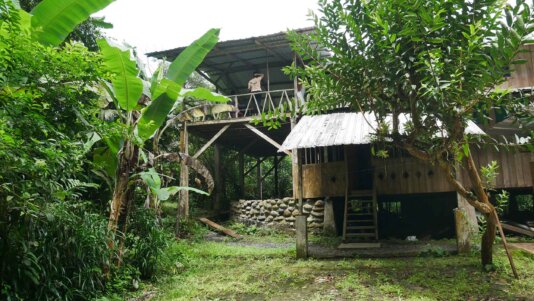- About
- Topics
- Picks
- Audio
- Story
- In-Depth
- Opinion
- News
- Donate
-
Signup for our newsletterOur Editors' Best Picks.Send
Read, Debate: Engage.
| August 24, 2023 | |
|---|---|
| topic: | Climate action |
| tags: | #climate change, #Ecuador, #Sustainable Agriculture, #El Nino |
| located: | Ecuador |
| by: | Kata Karáth |
For the past few weeks, a consistent downpour has enveloped Cristóbal Colón, a village nestled in Ecuador’s Esmeraldas province. This coastal area, known for its emerald-hued rainforests, is familiar with intense rainfalls, but during the summer months from May to August, a temporary respite from the incessant showers is usually expected.
This sunny spell is essential for local cacao farmers, as warmer and drier weather helps their plants to fully mature.
"We’re harvesting much less cacao than before. The flowers fall off in this cold, rainy weather," said Manuel Loyola Qriñones, an 86-years old retired farmer who has cultivated cacao throughout his life. His 20 hectares of land are located about 4-hours away on foot from Cristóbal Colón.
Qriñones now lives in the village, but his sons continue producing cacao on the same farm. "This is rather irregular weather. It shouldn’t rain this much during the summer months. We have issues even drying the harvested cacao beans in open air," he said, adding that he is worried about how the extreme rainfalls brought by El Niño will affect his family’s produce.
"Before we managed to produce three to four quintals (3-400 kg) every eighth day, but these days we are lucky if we can get one to two quintals (1-200 kg)," he lamented. Notably, the price of cacao beans in Ecuador fluctuates drastically, ranging anywhere between USD 50 to USD 135 per quintal.
But Qriñones is not alone in his worries about the looming El Niño. The cultivation of cacao, along with crops like rice, banana, sugar cane and maize, is anticipated to suffer the greatest impact due to the excessive levels of rainfall that the peak phase of El Niño is expected to bring to Ecuador from November 2023 to January 2024.
El Niño is a climate phenomenon that occurs when surface waters in the eastern equatorial Pacific Ocean experience unusual warming. This happens every three to seven years or so, and it can last a few months to a couple of years. The impacts of El Niño events on local weather and climate vary around the world, but can be particularly potent in South America, bringing heavy rainfall to Ecuador and extreme drought to Chile.
Scientists have confirmed that we are presently experiencing an El Niño event, but uncertainty lies in its potential intensity. The forthcoming peak phase of the 2023-2024 El Niño currently holds a likelihood of over 50 per cent for being robust and over 80 per cent for being of moderate strength.
"There is already data that indicates that we are experiencing an anomaly of 2.4 Celsius degree increase in the sea surface temperatures," Byron Delgado, a GIS researcher at the Charles Darwin Foundation in Ecuador's Galapagos Islands, told FairPlanet.
"In order to qualify for the presence of El Niño, we only need to have an anomaly of 0.5 Celsius degree increase. Having 2.5 Celsius degree could already categorise this El Niño as a strong one," he said, emphasising that the atmospheric conditions needed for the development of a strong El Niño are yet to match the conditions currently present in the ocean.
We would also need to observe a notable contrast in air pressure between the western and eastern segments of the equatorial Pacific Ocean, experts highlight. The air pressure must significantly exceed the usual levels above Northern Australia, while simultaneously registering much lower than usual readings around Tahiti.
Climate scientists in the area, including those utilising oceanic buoys positioned around the Galapagos Islands, persist in gathering real-time data to enhance their ability to make precise forecasts as El Niño evolves.
Ecuador’s Coastal Chamber of Agriculture estimates that around 80,000 hectares of agricultural land will be lost due to El Niño-triggered floods along the coast. The most affected areas are likely to be the provinces of Guayas, Los Ríos, El Oro, Manabí and Esmeraldas.
Banana producers have warned that roughly 50,000 hectares of plantations are at risk. This could potentially deal a substantial blow to Ecuador's economy, given that bananas are a cornerstone of the country's exports.
Meanwhile, farmers in the country’s Andean region are primarily troubled by the increased likelihood of widespread landslides that could affect not only agricultural production but the distribution of food products as well through the destruction of roads and bridges.
A July 2023 study by the Pichincha College of Economists (PCE) projected that Ecuador’s agricultural sector will suffer an economic setback ranging from USD 91 million to 136 million due to the effects of El Niño. Additionally, around two million cattle situated in low-lying areas are also under threat from potential floods, while livestock in elevated regions might confront a scarcity of feed grains.
El Niño is also predicted to affect Ecuador’s fisheries and aquaculture industry in numerous ways. This phenomenon heats the typically cool and nutrient-rich currents along the coastlines of Peru and Ecuador, causing fish to relocate and migrate away from these areas.
"Food for the local species is not enough, and many are not able to survive due to the increased competition," said Delgado. "So this climate variability may also offer greater opportunity for certain invasive marine species to adapt and spread."
The fishery and aquaculture industries (especially shrimp farms) represent the country’s third main source of revenue. The PCE study estimated that El Niño will cause a loss between USD 16 million and 23 million in these industries alone.
Ecuador has already been hit hard by El Niño previously, with nearly 300 casualties and a USD 3 billion loss in economic output due to El Niño in 1997-98.
This time, Corficolombia, a Colombian financial services company, projects a contraction of 1.6 percent in Ecuador's economic growth, along with a decrease of 1.7 percent in Peru and 0.6 percent in Colombia. Overall, the economy of South America is forecasted to suffer losses of approximately USD 300 billion due to the floods and droughts induced by El Niño.
Scientists have not yet reached a consensus regarding whether climate change has an influence on El Niño. However, historical records indicate that events occurring after 1950 have been more intense compared to those observed between 1850 and 1950.
Nevertheless, historical evidence reveals fluctuations in strength and frequency dating back to the 1400s. Notably, certain climate models suggest that forthcoming El Niño occurrences could be even more frequent and intense due to the impact of climate change.
"You have to look at two things; one is long-term climate events that people are going to slowly adapt to, while the other is extreme climate events," Israel Navarrete, a researcher at the International Potato Center, told FairPlanet.
"El Niño is a type of extreme event, of course, we know when it happens, but it is still an extreme climate event, so people have to react quickly. Alerts have to be issued in time so that farmers can take some measures."
In Ecuador, the government has designated USD 266 million for efforts to alleviate loss and damage. The country's Risk Management Secretariat has released a plan aimed at readiness and alleviation of El Niño's impacts. This encompasses the implementation of a long-anticipated early warning system, financial resources for road upkeep, drainage system enhancements, river protections, emergency shelters and provisions of food aid, among other measures.
However, the Ecuadorian Association of Municipalities has claimed that at least 61 municipalities have yet to receive the allocated prevention funds. Health authorities also warn that the country must take into account that floods will fuel outbreaks of mosquito-borne diseases such as dengue, which has already seen a surge in many South American countries over the last few months due to extensive rainfalls.
"We haven’t looked into whether farmers are specifically preparing for El Niño, but we do know about cases like in Chimborazo province, where people are adapting their cultivations to the effects of climate change," said Navarrete from the International Potato Center. He added that crop diversification, food forests and the restoration of local ecosystems, for instance through reforestation - especially along the coast, are sustainable practices that will help farmers brace for extreme events like El Niño and climate change more broadly.
Navarrete emphasised that the conservation and re-forestation of mangrove ecosystems along the Ecuadorian coast is particularly important for cities like Guayaquil, which is home to the biggest port along South America’s Pacific coast and is the country’s economic capital.
Guayaquil has long been suffering from intense floods due to heavy rainfalls and rising sea levels, which are intensified by climate change. But the mangrove forest that lies between the ocean and the city has been severely diminished due to the expansion of shrimp farms in the Guayas river estuary.
Back in Cristóbal Colón, Carlos Celi, a 37 years-old farmer, has also adopted a sustainable approach to protect his eight hectares of land from the ravages of climate change and El Niño.
"Instead of a monoculture, we use a so-called 'association of plants,' where we grow different kinds of crops together," Celi told FairPlanet. "This ecological approach helps us mitigate the impacts of climate change, including fending against plant diseases like fungi that too much humidity can bring."
He further explained that their diversified cultivation practices contribute to enhancing the mineral composition of the soil. Additionally, they have embraced agroforestry by planting 2050 trees on their land, which serves to safeguard against potential landslides.
He emphasised the necessity for a shift in people's perspective when it comes to monocultures, which heavily depend on excessive water and pesticide usage to sustain themselves in the face of a shifting climate. He pointed out that even people who planted kitchen gardens to feed their families during the covid-19 pandemic were heavily reliant on fertilizers.
El Niño might be an intermittent extreme weather phenomenon, but Celi has noticed a pronounced shift in the climate over the past two decades. If local farmers wish to continue cultivating their land for the well-being of future generations, he said, they must adopt more sustainable agricultural practices.
Image by NOAA.



By copying the embed code below, you agree to adhere to our republishing guidelines.